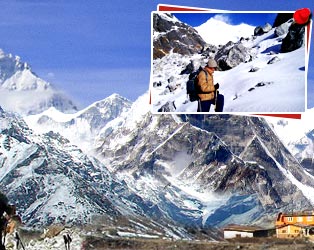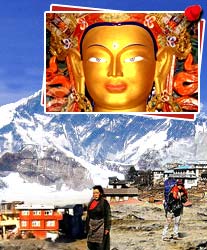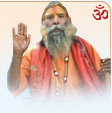The Buddhist monasteries in Tibet resonates the
atmosphere of spirituality, serenity, peacefulness and magic. The
frescos and the architectural features of the monasteries evoke the
actual essence of the Buddhist religion. The Buddhist monasteries in
Drepung, the Jokhang, a spirtual centre, and the majestic palaces of
Dalai Lama are the main attraction of the region. Norbulingka or the
summer Palace and the Potala - the Traditional Seat are some of the
highlights of visit.
Tibetan Monasteries
Samye:
It is the oldest monastery in Tibet. This monastery was founded during
the reign of King Trisong Detsen between 765 and 780 AD. Now Samye
monastery is a major tourist destination. The frescos and the
architectural features of this monastery is a major attraction. The
architecture of this monastery reflects the style of the Odantapuri
temple in Bihur, India. The central temple symbolizes a mountain, and
those around it are oceans and continents.
Lhasa:
It is situated in a fertile plain along the Lhasa River, a Brahmaputra
tributary. Lhasa known as "God's place" is considered as the
religious, commercial, and political center of Tibet. In the heart of
Lhasa is the Jokhang, a spirtual centre, which was built by King
Songtsen Gampo during 637 and 647 AD. This shrine was built to store an
image of Lord Buddha, the dowry of his wife Princess Bhrikuti. The image
of Buddha is still found inside the shrine. You can also found the
Norbulingka, summer palace of the Dalai Lama in Lhasa. And several other
monasteries like Dreprung, Sera, and Nechung, which are situated just
outside the city. The most famous shrine of Lhasa is the Potala palace,
built by Ngawang Lozang Gyatso during1617 and 1682.
Reting:
This is situated in the Rong Chu Valley of Central Tibet. It was
founded in 1056 AD. The monastery was initially associated with the
Indian scholar Atisha but later it had important ties to the Dalai Lamas
and the Gelugpa Order. The monastery has wall paintings of venerable
lamas and Tantric gods in the assembly hall and a much-revered gold
statue of Guhyasumaja, usually defined as the personal Tantric deity of
Atisha. It was destroyed when the Communist took over, but now the
monastery is slowly rebuilt.
Among the other monasteries are
Dung-kar:
Situated in the valley of Tro-mo just north of Yatung Monastery. The
monastery has a large courtyard, which is surrounded by wooden
buildings.
Sakya:
It is located at a height of 4280 m in the province of Tsang; it has
two monasteries on the north and south sides of the Trum River.
Ganden:
Ganden is the first and main Gelugpa monastery, which was established
by Tsong-kapa in 1417. It is situated 40 km east of Lhasa.
Dreprung is another monastery, which is situated only three
miles west of Lhasa. A monk who was a disciple of Tsong-kapa named
Jamyang Chöje established this monastery. It is one of the most
popular religious centers in Tibet.
Other monasteries, which you can visit, are Tashilhunpo Monastery
and Kumbum Monastery to name a few.



